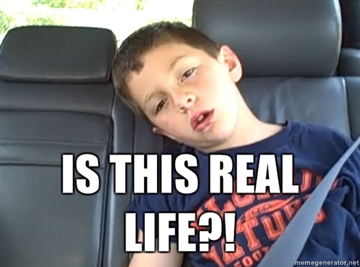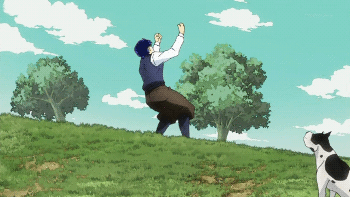Kill La Kill Documentary-500 Days of Hell
So I've been meaning to watch this. Why? Good question considering I didn't like the show. It covers roughly 500 days from pre-production to a little past the initial airdate of the show. It's similar in nature to the Little Witch Academia documentary but has more interviews and breaks down the production process a bit more, rather than focusing on the individual animators. It's also twice as long and is broken up into two hour long segment. The work is a bit ostentatious not only in the visual presentation but some of the verbal handjobs given out.
I'm looking forward to his masterpiece in Xenoblade X.
I can't exactly blame them as the purpose of this documentary is more for marketing purposes rather than being an actual nitty gritty documentary. That's not to say that it shies away from difficulties in the production but it's not particularly introspective either. It starts off with Sushio showing off different designs for Sanageyama aka Monkey. Some of his earlier designs resembled Shinji out of Fate/Stay Night.
I remember reading
this interview where he had a lot of trouble coming up with Ryouko and Satsuki's designs. Sushio looks completely fried in the recorded design meeting. He claims that he draws better when he's tired so going by his appearance there, he must have been putting out his best work. Anyway something that got across in this documentary is how damn long some of these meetings end up being. You would think they would go for a couple of hours, not eight!
I'm not familiar enough with other anime directors to say whether Imaishi's directorial style is unique, in that he wants it to be a collaborative effort. For him it's about maximizing the potential of the people around him. The documentary put a lot of effort into stating how for 'Team Imaishi' that it's all one big team push. That's kind of interesting in that for a few things he's apparently hands-off like the OP but he's also there for all the episode recordings and revisions. For example, him and Nakashima are the ones doing the corrections to stuff like the dialogue in episode 7, Mako's fight club episode. I don't know how typical some of this stuff is, so I can't say for certain whether he takes a team based approach.
A wild Nakashima appears and the documentary jumps back to some early scenario meetings. One thing they focused on was how Ryuuko kept losing initially and how Imaishi liked that. He felt that the audience could more easily connect with Ryuuko and see her progression as a character compared to her being super-capable from the get-go. That's something I did like about the earlier episodes but I felt that they dragged that aspect of her character out too long in the show. The changes in narrative direction have long been known in that the earlier drafts of the show were more episodic and battle royale focused compared to the one we got.
Mako's Hallelujah scenes had more animation to them initially but Imaishi thought that hurt the point of it being gag. Hence my initial images in this post with Imaishi returning them saying "Sorry". He felt that if her stuff was well animated then it would lose the impact of being a joke and be lost in the shuffle. It's an element that the show uses to death, with not only Mako but later Nui. I guess it kinda reminds me of complaints levied at the Simpsons, in how the directors wanted bad animation. Maybe if the rest of the show had super high production values, Mako's 'limited animation' would have come off better rather than it appearing to be a budget/time saving maneuver.
Afterwards there's some shit with Sawano and they're doing some changes to Satsuki's theme. While watching/listening to the performance, I was actually wondering if her theme was as bad as it's presented in the documentary in how boring it is. I ended up going to the OST and re-listening to her theme to make sure it wasn't as awful as it's presented here. That's probably due to the audience only seeing one section of the song rather than how the full thing comes together, although they do listen in to a recording of the final version. Sawano's right hand man was doing some modification to the violin team playing double notes but I can't for the life of me tell a difference. That's something I like about the documentary in that they usually provide 'before' and 'after' comparisons so that the audience can judge for themselves.
I really enjoyed Kaneko's section of the documentary as I thought he did an outstanding job as art director. That's one of the few areas where I feel Kill La Kill really hit a homerun. They discuss something called Kill La Kill Harmony but that feels like it's an extension of Dezaki postcards (something the documentary brings up in the 2nd part). It's interesting to note that Kaneko states that stuff like the previously mentioned was a coping mechanism for production issues but instead they're taking advantage of it. That was a complaint I had when watching the show in that I felt they abused the postcard moments instead of using them just for the really special moments.
dat Trigger production schedule
It's already well known that Yoshinari did the storyboards for the first OP but it's kinda interesting how it was handed off to him. Apparently Imaishi sort of dumped it on him and Yoshinari had a month to do the storyboards and key animations for the OP.
Unsurprisingly, Yoshinari's storyboards were fairly complex, almost too much so. Otsuka was like if another animator had handed him the storyboards he would have asked, "And who's going to animate this? You?" but it seems like it was already known that Yoshinari was going to do the key animation for the
insane 20 second cut. This ended up causing problems down the road as he actually couldn't finish on time. He had to do over 120+ drawings in a week to finish it.
http://webm.host/d4750/vid.webm
You know he's thinking, "Bitch get off my back".
Dude looked broken when he handed the rest of it in. Just dragging his feet, like he was sleepwalking. Honestly I don't know how someone is expected to have a personal life in this industry when you might not go home for days on end and accidentally pull all nighters for things such as corrections. Shirobako touched on this but it's kinda depressing when you see the effects on actual people. I mean look at this:
Oh and there was no AC in the building past midnight hence the popsicles.
They ended up staying 10 hours to the point that the sun was shining when they left the studio. I don't even want to know who went straight back to the office to continue drawing. That's how people drop dead.
I can't begin to imagine how those offices smell.
Now I understand part of this was due to poor production planning on the part of Trigger, but it seems this is closer to the norm than otherwise. It's got to be heartbreaking to work non-stop for a week to get one of these projects done, only for the public to shit on it or for it to bomb financially. I understand that's the risk for any and all creative endeavors but seeing these people suffer, for a show that I don't even consider good, is kind of sad. You're sacrificing your social life for a job that barely pays. Anyway rant aside, the 2nd part covered things like the recording for episode 7.
No shit. What the hell are you talking about?
Seems like they had problem with Aya Suzaki, Mako's VA. She's a relatively new VA and wasn't delivering the scene how the director and Nakashima wanted it and they had to do a number of takes. Going by the 'before' and 'after' version, her earlier performances didn't have the seriousness the scene required. She was a bit too peppy I guess, and her final version is more sombre. There's also an interview with Yoshikazu Iwanami, the guy currently fucking up with Fate/Stay Night UBW. He doesn't say anything novel other than that he wanted to bring an energy to the show and that he wanted to use as little takes as possible.
Shouldn't that have been the case long before the broadcast date?
The 2nd part delves into how production gets accelerated the closer they get to airing. I guess Matsumoto fills in for Masao Maruyama, in that he orders food for the team. It also talks about how Imaishi uses CGI for stuff that would be a pain in the ass to do manually nowadays, like motion on a flight of stairs. With the way he views CGI animators as being just like a normal animator, I don't think he would go back to a work that didn't use 3DCGI at all. It's sort of disappointing but the entire industry is headed down that path.
What I got from this was, I have no fucking clue why anyone would go into this industry. The stress level has to be through the roof. It's one thing seeing newbie animators struggling but it's another to see newbies and veterans alike almost ripping their hair out. It's like playing life on 'Extremely Hard Mode'. I wish the documentary went all through the way through the entire process as I want to see what production was like on the last four episodes. The last four in which Wakabayashi was describing as "hellish". Well that LWA2 documentary should be coming out in a couple of months, the part depicting this month (June) leading up to the premiere should be truly entertaining. There isn't any magic to this other than sleep deprivation, sweat, and body odor. The documentary was also somewhat informative as I had never heard of these two terms before:
I mean I had seen these stylistic flairs before and they're distinctive but I didn't know it had a proper industry term attached.



































